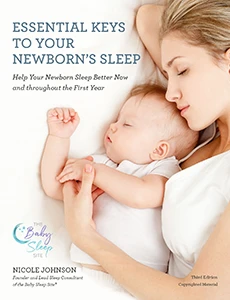
This is a guest post written by Judith McLean* When your toddler is ready to make the transition from crib to their first bed, it’s a milestone often accompanied by lots of exciting decisions, from selecting new bedroom decor to choosing the right bedding. It’s usually only once you’ve decided on the bed and bought the duvet and bedding set that you start thinking about important safety questions, such as: when can your toddler sleep with a pillow?
Why Can’t Babies Use Pillows?
Unlike adults, babies do not have the same amount of head and neck movement or control, meaning they are at risk of suffocation, since they will not be able to move in the event that their breathing becomes obstructed. Therefore, pillows, blankets, and any other material with the potential to cover the mouth and nostrils are not appropriate or deemed safe.
In fact, the expert advice is clear and the American Academy of Pediatrics (AAP) recommends all parents to lay their babies on their backs to sleep and to use a flat and firm surface devoid of pillows, blankets, and bumpers.
When Should You Introduce a Pillow?
This is a difficult question to respond to and since all children develop at different rates there is no clear-cut answer. The majority of toddlers still won’t need a pillow when they first make the move to a bed. However, experts are clear on one thing – toddlers under the age of 18 months shouldn’t be given pillows at all. After this age (typically at age 2+ years), and when you believe your child is ready, ensure you select a pillow that is appropriate.
When choosing your toddler’s first pillow, ensure it’s firm and appropriate size. That way it will provide support and comfort, without the risk of them getting lost. You may find this is a case of trial and error until you find a pillow that works well for your child. Today, there are a variety of filler materials used including feathers, memory foam, buckwheat, and fiberfill, and the one you choose is largely a personal matter. However, feathers are probably less favorable. They are too soft for a toddler and a common trigger for allergy sufferers.
The best material for a toddler pillow is 100% cotton filling, This is a reasonably firm, extremely comfortable, and hypoallergenic material.
Other Factors to Consider for Safe Toddler Sleep
Once you’ve got your pillow dilemma solved, there are some other important things to consider in your child’s bedroom to ensure safe toddler sleep. These are some of the fundamentals:
- Secure Furniture to the Walls
Babies and toddlers are naturally inquisitive. They cannot make the same judgments as adults. Climbing and tugging at furniture is something that you have to expect. You simply aren’t going to be able to have your eyes on them 24 hours a day. Therefore, the best way to ensure their safety is to secure all furniture to walls. This way, there’s no risk of them falling over onto your child. This includes dressers, bookcases, TVs, and TV stands. Objects with sharp corners are another consideration. Try to select furniture with rounded edges and if you can those made from softer materials. If you don’t plan on buying all new furniture, then you may want to think about childproofing any areas of concern. - Choose an Appropriate Bed
What is an appropriate bed for a toddler? The majority of sleep experts agree that there’s no need to rush into making the transition from crib to bed. The safest option for children under the age of 3 years is a crib with a low-set mattress. When you think they are ready to make the move, you have the choice of either a “regular bed” or a smaller “toddler bed.” Regular beds are fine if you have the space. However, some parents find transitioning from a crib to such a large bed can present issues. Whichever you choose, remember that you are going to need guard rails to stop them from falling out. These usually come as standard on beds designed for the toddler age group. However, if you select a regular bed remember that you will need to fit safety rails. - Remove all Suffocation & Strangulation Hazards
Once you have the sleeping arrangement established it’s important to assess the room for potential hazards that put your toddler at risk. This includes blind cords and other cords on lamps and electric appliances such as TVs. Ensure you secure these appropriately and if necessary remove them completely. Now that you’ve taken the time to “toddler-proof” the bedroom, what’s next? Spend some time looking for other potential hazards. For instance, are all power outlets secured? - Check Smoke Alarms
If you don’t have smoke alarms fitted in your home, it’s time to change that. They will keep you and your family safe. It may be a good idea to teach your child what to do in the event of a fire too. - Don’t Forget About Carbon Monoxide
Carbon monoxide is often overlooked by many homeowners. What makes it dangerous is that it’s an odorless, colorless, and toxic gas. It’s certainly worth having CO detectors installed. Make sure to fit them as directed by the manufacturer. - Keep Your Child Informed
Once your child reaches an age where they can communicate and remember information, make sure you equip them with key details that could be extremely helpful in the event of a crisis. You may have to repeat yourself many times! But ensure they can provide your name, and eventually telephone number and address. If they ever find themselves in an unfortunate circumstance, at least you will know they can provide some assistance to the emergency services.
___________________________________________________________________________________
Judith McLean is a mother of four, an educator, and has written extensively on the topic of parenting.








